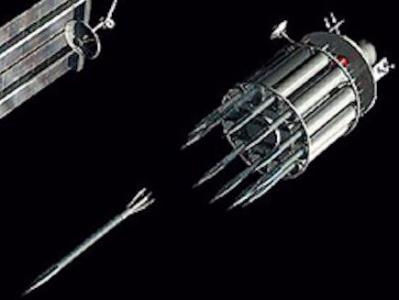Sic transit gloria mundi

OUT OF CHARACTER INFORMATION
Intent: Sub a cannon.
Image Source: Here.
Canon Link: N/A.
Permissions: N/A.
Primary Source: N/A.
PRODUCTION INFORMATION
Manufacturer: Firemane Industries.
Affiliation: Firemane Industries.
Market Status: Closed-Market
Model: FM-OPC Mk1
Modularity: Can be mounted on different vessels.
Production: Limited
Material: Duranium, Neuranium, Thorilide, Isotope-5, Dallorian Alloy, electronics, standard railgun components.
TECHNICAL SPECIFICATIONS
Classification: Hypervelocity Cannon.
Size: Large
Weight: Heavy
Ammunition Type: Neuranium rods.
Ammunition Capacity: Average
Effective Range: Extreme
Rate of Fire: Low
Damage Output: Extreme.
Recoil: High
SPECIAL FEATURES
- The projectiles fired by the cannon are large, arrow-like rods made of Neuranium, a remarkably dense, heavy metal. Propelled by the railgun, the projectile drops from rabit and reaches a speed faster than sound.
- Cannon be synced to laser designators used by spotters, drones etc. in order to enhance accuracy and support the gunners.
- The construction of the cannon incorporates Dallorian Alloy, an inherently very heat-resistant material, to deal with the potential issue overheating and warping of the electromagnetic rails and coils. Thorilide is used as a shock absorber to alleviate issues created by the recoil and thereby keep the weapon manageable.
- It is a big cannon that fires Neuranium rods. Neuranium is super dense. More weight and speed means it has the potential to inflict incredible amounts of damage. The rods are propelled at hyper-velocity. Ideal for cracking static, hardened targets.
- As a hypervelocity cannon, it also has an incredible range. Ideal for carrying out kinetic orbital bombardment.
- Pointed right down towards a planet or other sort of celestial object, the cannon has no real use during fleet battles.
- Tying in with the above, the cannon is big, heavy and consumes a good deal of power. Thus its deployment must be considered carefully. Not only is it power-intensive, it takes up a good deal of space. It cannot be scaled down for use by starfighters, dropships and the like. The cannon can only be mounted on a ship, satellite or station able to support a hypervelocity cannon.
- Unlike energy weapons it generates recoil. The kick is manageable, but means this is not something to mount on a light or small vessel.
- The potential damage of the weapon is devastating. However, as it is concentrated, it is not an AOE weapon. Great for smashing a hardened, static target it is fired at, but not the weapon to carpet bomb a city block with.
Sometimes anti-air defences and the like make a bomber impractical. But a turbolaser or missile bombardment might be too devastating. The Gandiva Class Orbital Projectile Cannon is supposed to solve this issue via kinetic bombardment from orbit. As the name implies, it is a big hypervelocity cannon. The incredible speed at which the projectiles are propelled makes interception very difficult. Mounted on a starship, it is pointed right down on the planet or whichever celestial object the ship is taking aim at. The weapon is power-intensive, has no use in space and is less effective against very fast moving targets on the ground, but ideal at cracking static, hardened targets such as bunkers, command centres, ground-to-space emplacements and the like. The Gandiva is named after a celestia bow wielded by one of the mythical heroes of Qadiri mythology. The project was initiated during the tenure of Director Kaylah Danton as Firemane's 'regent'. Alas, Lady Siobhan Kerrigan missed the field test due to being in coma.
The cannon fires rods made of Neuranium, an extremely dense material. This means more weight, and thus more speed and greater kinetic force. As with any hypervelocity cannon, the rods are super-accelerated at launch. While damage can be devastating, it is concentrated. Any Star Destroyer’s turbolasers or a couple bomber squadrons can level city blocks in a far more cost-effective manner. Likewise, it is cheaper to bomb ground convoys with a bunch of heavy bombers. The point of this weapon is to destroy specific hardened targets that are of strategic importance to the enemy, such as command, control and communications infrastructure, underground bunkers, artillery positions etc. Naturally it could also be employed for targeted assassinations in that capacity, assuming more conventional methods are deemed to be lacking in efficacy.
In order to fire, the ship the weapon is mounted on needs to be in the right position in orbit. Having the appropriate sensors helps get a lock on the target to assure accuracy. Performance can be further enhanced with a comprehensive surveillance suite. It is best to have spotters on the ground or in the air who can provide accurate targeting data in real time. To this end, the weapon can be synced to laser designators used by the aforementioned spotters or drones such as the Nemesis. This is important to ensure that the rod will hit the correct target. Besides, the cannon has a low rate of fire, so making a shot matter is quite pertinent.
Last edited:








